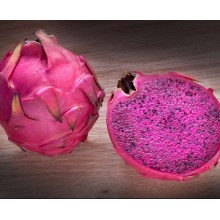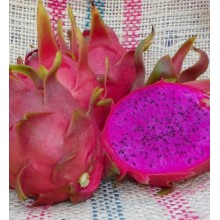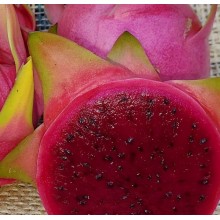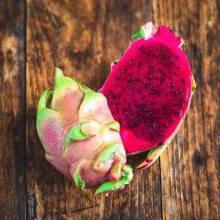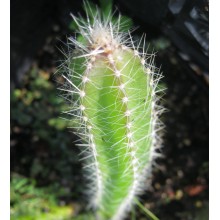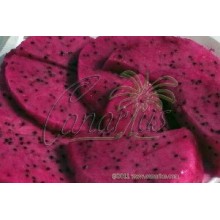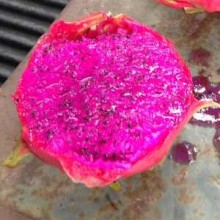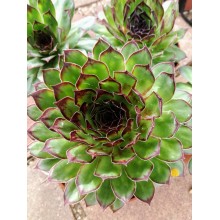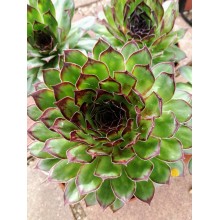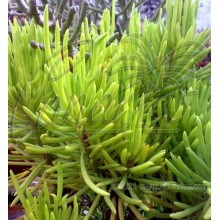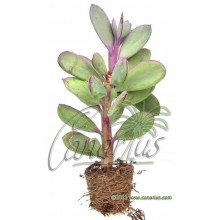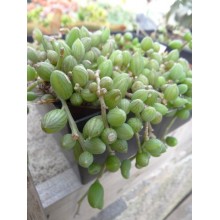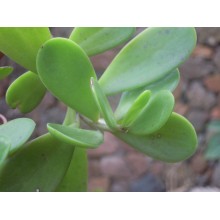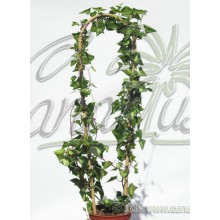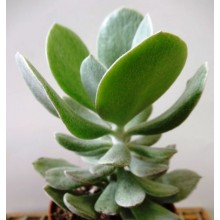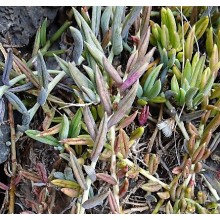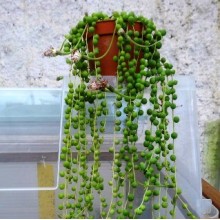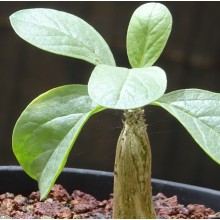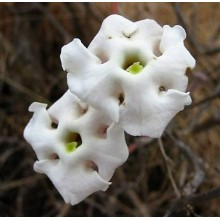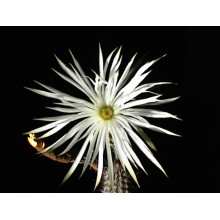Succulents There are 628 products.

World deserts and dry areas are home to the most interesting plants. Canarius offers an increasing selection of succulent plants of maximum quality, because they are grown outdoors, under the full sun of the Canary Islands.
Succulents or "fat plants" are water-retaining species, adapted to dry conditions. They store succum (juice, water) in their leaves, stems or roots, and often show a stout and fleshy appearance.
Subcategories
-
Agave
Agave is a genus of succulent plants from America. Some species grow in cold areas and take hard frost, while some others live in tropical climates. Some are tiny dwarfs and some are giants, up to 2 or 3 m wide.
Cold hardy agaves can create an exotic effect in your garden. Agave species make fine companions to palms or cacti. Variegated agaves are incredibly sought after by collectors. Our web shop offers an ever changing selection of species. We ship bare rooted plants, unless otherwise specified.
-
Aloe, Gasteria & Haworthia
Aloe, Gasteria and Haworthia are three related genera, comprising hundreds of succulent plants. They are all easily grown in pots. A few adapt to low-light levels of indoor conditions and can be grown as house plants.
- Aloe is a genus of about 400 species, native to Africa, Arabia and Madagascar. Small or dwarf aloes are becoming especially popular in colder climates as they can be taken indoors during the hardest months.
- Gasteria includes some 80 species endemic to South Africa, known for their spectacular leaves which are glossy, mottled and textured. They bloom in Spring-Summer with long spikes of small orange flowers. Some species are so variable that we offer particular clones from specific locations.
- Haworthia is a genus endemic to South Africa with about 70 species and a number of local subspecies, varieties and forms. Leaves are often banded, speckled, dotted, or semi-translucent and show wide variations.
-
Crassulaceae
This is a new, growing section of species from the family Crassulaceae. There are about 1,400 species in 33 genera and their distribution is worldwide, but mostly occur in the Northern Hemisphere and Southern Africa, especially in dry habitats. Here you can buy healthy, sun-hardened plants grown in the Canary Islands and shipped to your home.
-
Mesembs
This group of desert plants is briefly named Mesembs because they belong to a botanical family formerly named Mesembryanthemaceae. There are almost 2.000 species, mainly found in Southern Africa, with extreme adaptations to dry habitats. Some are called "living stones", as they look like pebbles. Many are easy to grow and their main need is full sun. Some are difficult because they grow in truly extreme areas.
Our Web Shop offers sun grown healthy plants, with compact and colourful leaves. Some plants are sold as cuttings, and others as rooted plants, of at least two years old.
-
Sansevieria
Recently assigned to the family Asparagaceae, the genus Sansevieria counts about 70 species, nearly all native to Africa, Arabia and Madagascar. Perennial herbs adapted to dry habitats with stiff, succulent leaves, their length ranges from a few centimeters to 2 meters. Sansevieria trifasciata and its many cultivars are among the most popular houseplants, popularly called mother in law's tongue. A well grown plant usually produces a spike of many white, richly scented flowers and then orange berries. Even the rarest species are resistant to neglect, provided you keep them from frost in winter and scorching sun in summer.
-
Hoya
Hoyas are twining vines, with showy exotic flowers, from the rainforests in Asia and Oceania. Most species grow in bright shade or morning sun, but they will also grow indoors as house plants. They are well suited for baskets, trellises or ladders. They tolerate a few weeks of drought but they are sensitive to frost and cold. Many hoyas are easy to grow and bloom, while some are tricky and rare.
-
Asclepiads
Asclepiads or Asclepiadoideae are a subfamily in the Apocynaceae, with about 2900 species. There are lots of leafless stem succulents but also perennial herbs, shrubs, lianas or rarely trees. They produce remarkable flowers, for the complex mechanisms they have developed for pollination. Many species produce an unusual fragrance, often called "carrion", and attracts flies for pollination. -
Caudiciforms
These plants from dry areas produce an unusually thick stem, the caudex. They are also called pachycauls and they have a disproportionately thick trunk, often with few branches. The caudex can be hidden underground, but in most cases they grow upwards, forming spectacular trees. The largest caudiciforms in the world are the baobabs. -
Other succulents
Here you will find all those species of desert plants that are not included in their own category. We will place here all plants from unusual families, other than Agaves, Aloes, Crassulaceae, Sansevieria, Mesembs, Epiphytic cacti, etc.
-
Selenicereus 'Sin Espinas'
Selenicereus 'Sin Espinas'
This thornless variety comes from the genus Hylocereus and an unknown species native to Nicaragua. The fruits average size is a pound with thick pink skin with green fins and it has deep red flesh. The most interesting aspect of this variety is its lack of spins.Rooted cutting of 20-25 cm.
21,70 € -
Selenicereus costaricensis - Costa Rican Dragon Fruit
Selenicereus costaricensis - Costa Rican Dragon Fruit
Wild dragonfruit with red, sweet and tasty fruits. It grows wild in central america in dry forests. This is the ancestor of many modern hybrids and to many conoisseurs it is still the tastiest, and the "real thing". Its fruits are all-red, especially rich in healthy indicaxanthin anti-oxidants.
28,50 € -
Selenicereus purpusii - Pitahaya, Purple Dragon Fruit
Selenicereus purpusii - Pitahaya, Purple Dragon Fruit
20-25 cm Rooted cutting. A climbing cactus with excellent fruits, with purple skin and flesh. It is a very good pollinator for the other ones. It needs a pollinator, and the best is H. undatus. VISIT OUR SECTION OF FRUIT TREES A-Z AND FIND MANY MORE HYLOCEREUS
21,70 € -
Selenicereus undatus 'Condor'
Selenicereus undatus 'Condor'
"Self-pollinating" cultivar with large oval shaped fruit up to 700g in weight, with a skin which is at first light green with pinkish shades which darken to pinkish red as the fruit ripens. The flesh is dark purple colour with many small dark edible seeds. The taste of this variety is described as very peculiar and pleasant to the palate.
21,70 € -
Sempervivum calcareus
Sempervivum calcareus
Native to Southern Eruope from about 200 to 2800 m, it has neat stolinferous rosettes with a red hue, and ciliate ("Hairy") leaf margins. It naturally grows in rocky outcrops and cliffs, but it became well known in ancient times since it was typically found on roofs, hence the name "tectorum", meaning "of the roofs"
10,70 € -
Sempervivum tectorum
Sempervivum tectorum
Native to Southern Eruope from about 200 to 2800 m, it has neat stolinferous rosettes with a red hue, and ciliate ("Hairy") leaf margins. It naturally grows in rocky outcrops and cliffs, but it became well known in ancient times since it was typically found on roofs, hence the name "tectorum", meaning "of the roofs"
10,70 € -
Senecio barbertonicus
Senecio barbertonicus
Small shrub, Bright green succulent leaves held upright and are crowded toward tips. Orange yellow clusters of flowers appear in late autumn. It is probably the largest species in the group of senecios with cylindrical leaves...
10,80 € -
Senecio crassissimus
Senecio crassissimus
Cont.= 8,5 cm - This species from Madagascar grows as a low shrub. Multiple stems have flattened obovate leaves, glaucous gray with purple margin in strong light. Yellow flowers. Suitable for pots or frost-free gardens.
10,70 € -
Senecio jacobsenii
Senecio jacobsenii
Creeping Senecio from E Africa with glossy leaves. It can be used in baskets or as a ground cover. It is called in English Trailing Jade Plant.
10,40 € -
Senecio macroglossus variegata
Senecio macroglossus variegata
Cont.= 8,5 cm - This climbing plant is called Flowering Ivy, because its leaves and habit looks like an ivy but it bear daisy-like flowers. It is native to the Eastern coast of South Africa and it is frost sensitive.
10,80 € -
Senecio medley-woodii
Senecio medley-woodii
Branched succulent shrub up to 2 m tall, with white-felted stems and leaves. It bears solitary yellow "daisies" 15 mm in diameter in Winter.
10,20 € -
Sesamothamnus rivae
Sesamothamnus rivae
Rooted cutting, at least 1 year old, with one ore more new growths.
23,20 € -
Setiechinopsis mirabilis
Setiechinopsis mirabilis
Fascinating cactus from Argentina with dark, almost-black stems, and showy night-blooming white flowers held on a long calyx. They only last one night but they are produced profusely throughout summer and they have a wonderful spicy scent.
13,50 €
At the moment there are few products in this category Succulents

























